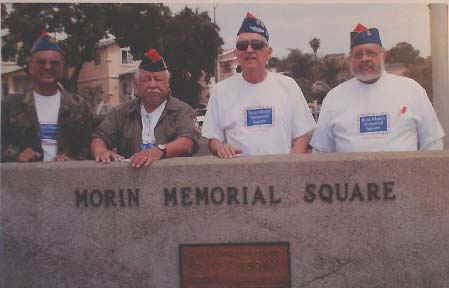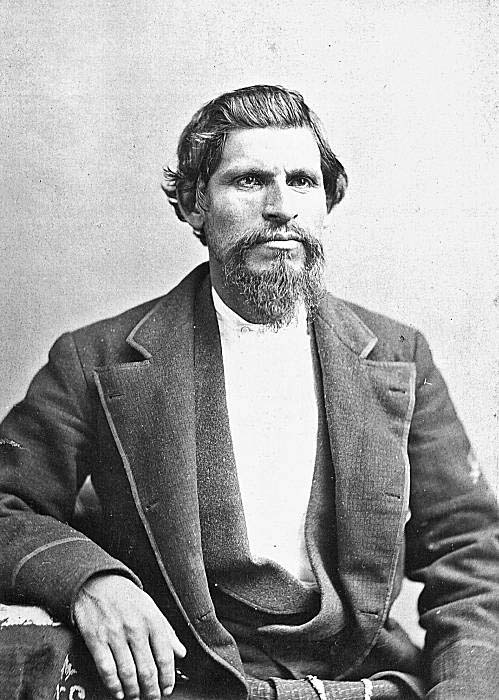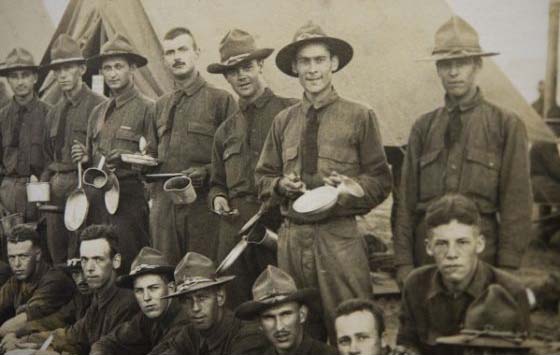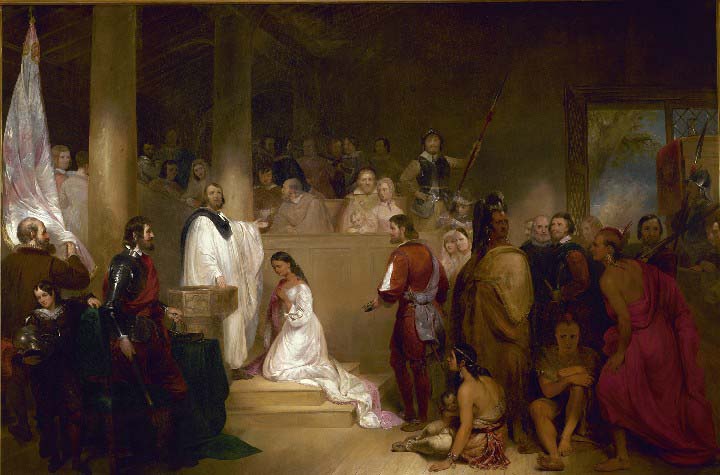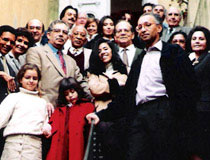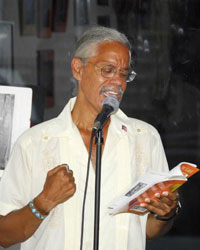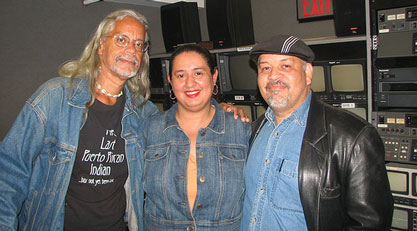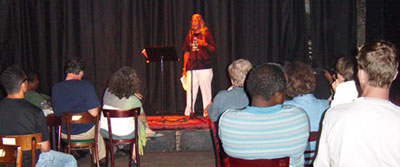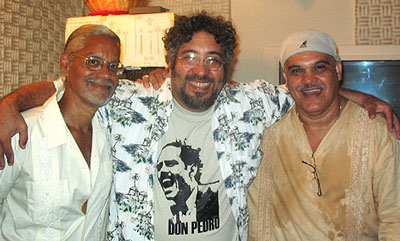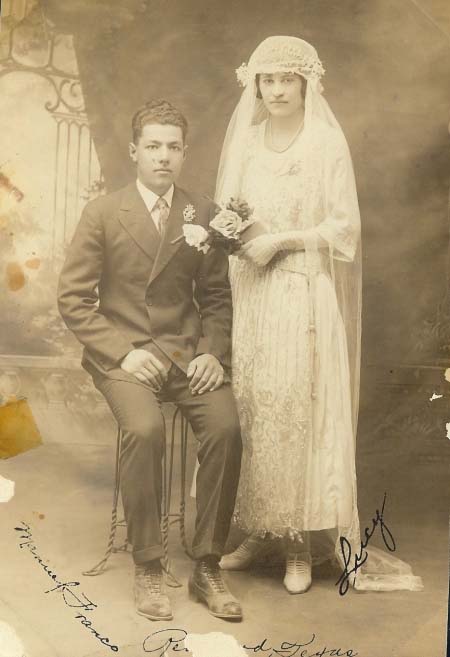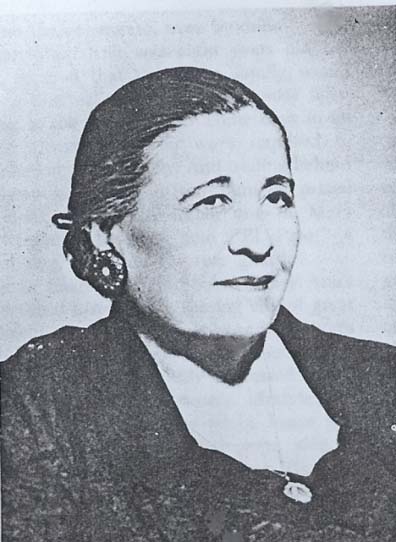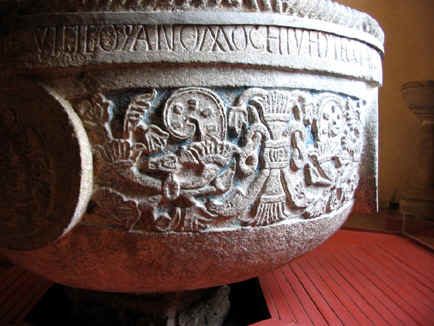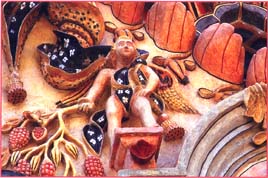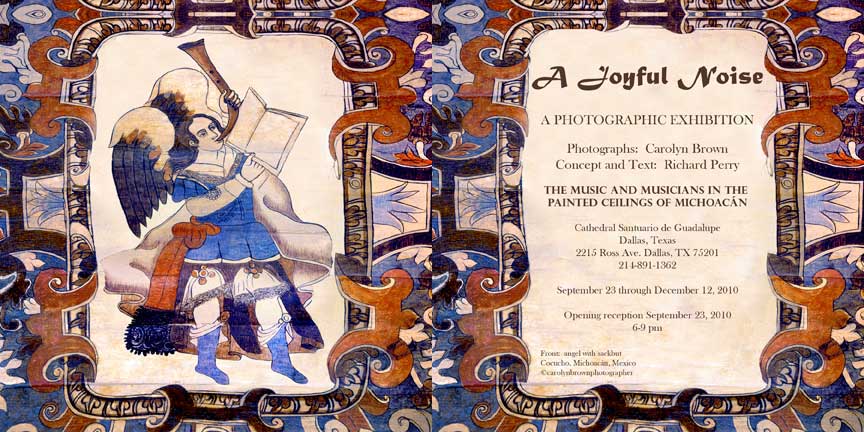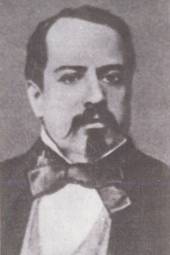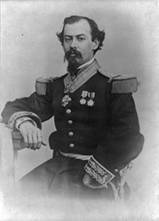SOLDIERS OF THE [ANZA 1775] EXPEDITION As the soldiers of Anza's expedition were the founders and first settlers of the city of San Francisco, it becomes a matter of historical importance to know who and what they were. They left their imprint on the civilization of California and their names are as familiar as household words to all who know the country. The list is now given for the first time and the particulars concerning the families were taken from the Spanish archives of California, destroyed by the fire of 1906. In giving the members of the families I only enumerate the children accompanying the expedition. Many more were born in California.
1. Ensign José Joaquin Moraga was born in 1741; died in San Francisco and was buried July 15, 1785, in the mission church whose corner stone he laid in 1782. Moraga was an able assistant to Anza and received his commission as lieutenant on the arrival of the expedition at San Gabriel. He accompanied his commander on the survey of the peninsula and river of San Francisco, and on Anza's departure for Mexico, took command of the expedition. He founded the presidio and mission of San Francisco and was the first commander, retaining the position until his death nine years later. He founded the mission of Santa Clara in 1777, and in the same year the pueblo of San José Guadalupe (San José). His record as an officer is an honorable and stainless one. His wife was María del Pilar de Leon y
Barcelo. She did not accompany the expedition, being sick in Terrenate at the time, but with her son Gabriel, joined her husband in San Francisco February 20, 1791, the government paying the cost of transportation: three hundred and eighty dollars and twenty-five cents. The only child of Moraga I find any record of was his son Gabriel, born at the presidio of
Fronteras, Sonora, in 1765; buried in Santa Barbara, California, June 15, 1823; married, first, Ana María, daughter of Juan Francisco Bernal; second,
Joaquina, daughter of Francisco Javier Alvarado, and sister of Pio Pico's wife. Don Gabriel enlisted in the San Francisco company December 1, 1783, and served for twenty-two years as private, corporal, and sergeant, at the presidios of San Francisco and Monterey and in command of various mission escoltas of those districts. On March 10, 1806, he received his commission as alférez and was assigned to the San Francisco garrison. On August 16, 1811, he was made brevet lieutenant for gallantry in a battle with the Indians on the strait of
Carquines, and on October 30, 1817, he was made a full lieutenant and ordered to Santa Barbara. His hoja de servicios of December 1820, shows thirty-seven years service and forty-six expeditions against the Indians. He applied for retirement on account of chronic rheumatism and other infirmities, and Governor
Sola, Captain José Darío Argüello, and other officers, as well as padres Señan and
Payeras, testified in terms of highest praise regarding his character and the value of his services, but no attention was paid to his request. In 1806 Moraga explored and named the San Joaquin river and he made a number of expeditions to and beyond the
Tulares. Don Gabriel is described as a tall, well built man of dark complexion, brave, gentlemanly, and the foremost soldier of his day in California. His son Joaquin, was grantee of Rancho Laguna de los Palos Colorados in Contra Costa county, and a portion of Moraga valley on said rancho is still in possession of his descendants. Another son, Vicente, was grantee of Pauba in Riverside county.
2. Sergeant Juan Pablo Grijalva was born in La Valle de San Luis, Sonora, in 1742; died in San Diego, California, June 21, 1806. He enlisted in the presidial company of
Terrenate, Sonora, January 1, 1763, and served twenty-four years in the ranks before he received a commission—eleven of them at the presidio of San Francisco. On the 20th of July 1787, he was commissioned alférez and attached to the San Diego company. In 1796 he applied for retirement on account of infirmities contracted during his long services. Governor Borica endorsed his application, recommending that he be retired with the rank of lieutenant as a reward for his services to the king. He was retired as alférez with half pay—two hundred dollars a year. The following November he was made lieutenant, his pension remaining the same. Grijalva brought with him in the expedition his wife, María Dolores Valencia, and three children: María
Josefa, age nine; María del Carmen, age four; and Claudio, a baby. Josefa married Sergeant Antonio Yorba, who came with Portolá in 1769 as sergeant of Catalan volunteers. She became the mother of one of California's great families, grantees of Santa Ana de Santiago, Las
Bolsas, and Lomas de Santiago. Carmen married Pedro Regalado Peralta, son of Gabriel. Of Claudio I know nothing. The name of Grijalva died out in California.
3. Corporal Domingo Alviso
lived but a short time after reaching San Francisco. He was buried March 11, 1777, and the libro de difuntos gives neither age nor place of birth. With him came his wife, María Angela Trejo, and four children: Francisco Javier, age ten; Francisco, age nine; María
Loreta, age five; and Ignacio, age three. The family became a large and influential one and were grantees of
Natividad, Cañada Verde y Arroyo de la Purisima, Milpitas, Potrero de los Cerritos, El Quito, Cañada de los Vaqueros, and Rincon de los
Esteros. The town of Alviso was named for Ignacio.
4. Corporal José Valerio Mesa was born in 1734 in
Opodepe, a mission on the Horcasitas river a little above San Miguel in Sonora. His wife, María Leonor
Barboa, and six children, born at the presidio of Altar, accompanied him to California. They were: José Joaquin, age twelve; José Ignacio, age nine; Ignacio Dolores, age eight; María Manuela, age seven; José Antonio, and Juan, age three. Valerio's grandson, Juan
Prado, son of José Antonio, became an ensign and comandante of San Francisco under Vallejo. This family received the following grants: San Antonio (Santa Clara county), Los Médanos, Rinconada del Arroyo de San
Francisquito, and Soulajule.
5. Corporal Gabriel Peralta was born at the presidio of
Terrenate, in Sonora, in 1731; died in Santa Clara, California, October 22, 1807. His wife, Francisca Javier Valenzuela, and four children: Juan José, age eighteen; Luis María, age seventeen; Pedro
Regalado, age eleven; and María Gertrudis, age nine, accompanied the expedition. Luis María enlisted in the Monterey company December 2, 1781, and served in the ranks for forty-five years. He was eight years a private, twelve years a corporal, and twenty-five years a sergeant. He was a soldier, engaged in many expeditions against the Indians, and was several times recommended for promotion to the commission grade of alférez, but never received it. He was retired invalido in 1826, and died in San José in 1851, aged ninety-three.
On June 20, 1820, Don Pablo Vicente de Sola, governor of California, granted to Sergeant Luis Peralta the San Antonio rancho, eleven square leagues—48,825 acres, perhaps the most famous as well as the most valuable of all the California grants. It includes the sites of the cities of Oakland, Alameda, and Berkeley. The Rinconada de los Gatos, the Cañada del Corte Madera, and the San Ramon ranchos were also given to the descendants of Corporal Peralta.
6. Juan Antonio Amézquita
was born in Metape, Sonora, in 1739. He enlisted at the presidio of Tubac July 9, 1764, and was retired invalido November 1, 1788. On October 1, 1786, he was transferred to Monterey where in 1813 he was living with his third wife, María Micaela
Sotelo. Juan Antonio's wife, Juana María de Guana, and five children: Manuel Domingo, age twenty-three; María
Josefa, age twenty; María Dolores, age ten; María Gertrudis, age about three; and María de los Reyes, a babe, came with the expedition. With this family was Rosalia Zamora, wife of the oldest son, Manuel Domingo—who was also called Salvador Manuel and Manuel Francisco. María Josefa became the wife of Ensign Hermenegildo Sal.
7. José Ramon Bojorques, born in the city of Sinaloa in 1737, brought with him his wife, Francisca Romero, and three children: María Antonia, age fifteen, wife of José Tiburcio Vasquez; María
Micaela, age thirteen; and María Gertrudis, age twelve. With the family was the husband of María
Micaela, José Anastacio Higuera.
8. Justo Roberto Altamirano
was born in Aguage, Sonora, in 1745. He brought with him his wife, María Loreta
Delfin, and two sons: José Antonio and José Matias. Matias died in 1783, and José Antonio in 1789. Justo Roberto had a number of children born in San Francisco and Santa Clara, but the name has died out in California.
9. Ignacio Linares was born in San Miguel de Horcasitas in 1745; died in San José Guadalupe, California, June 5, 1805. His wife, María Gertrudis Rivas, and four children: María
Gertrudis, age seven; Juan José Ramon, age five; María Juliana, age four; and Salvador, age one; came with the expedition.
10. Carlos Gallegos brought his wife, María Josefa Espinosa, but no children. I know nothing about him except that he was sent to the mission of the Colorado and was killed by the Yumas in the rising of 1781.
The above ten constitute the veteran soldiers of the Sonora presidios who volunteered to cast their lot in California. The recruits were:
11. Juan Salvio Pacheco lived but a short time in California. I do not know the date or place of his birth. He died before July 21, 1777, but the family he founded became a large one. He brought with him to California his wife, María del Carmen del Valle, and five children: Miguel, age twenty; Ignacio, age fifteen; Ignacia
Gertrudis, age fifteen; Bartolomé Ignacio, age ten; and María Barbara, age ten. Juan Salvio's descendants were grantees of Potrero de los Cerritos, Arroyo de las
Nueces, Santa Rita, San José Rancho, San Ramon, Monte del Diablo, and Positos ranchos. The towns of Pacheco in Contra Costa and Pacheco in Mann counties are named for this family.
12. José Antonio Garcia was born in
Culiacan, Sonora, and died in Santa Clara, California, January 25, 1778, the first death recorded
(gente de razon) on the books of that mission. His wife, María Josefa de Acuña, and five children: María
Graciana, María Josefa, José Vicente, José Francisco, and Juan Guillermo, accompanied the expedition.
13. Pablo Pinto was born in the city of Sinaloa in 1732; buried in San Francisco December 1, 1783. He brought with him his wife, Francisca Javier
Ruelas, and four children: Juan María, age seventeen; Juana Santos, Juana Francisca, and José Marcelo. The husband of Juana Santos, Casimiro Varela, accompanied the family. Another daughter of Pablo Pinto was with the expedition—Teresa, wife of the
poblador, Nicolas Galindo. The marriage of Juana Francisca to Mariano Cordero, a soldier of the Monterey garrison, November 28, 1776, is the first marriage recorded in the libro de casamientos of San Francisco.
14. Antonio Quiterio Aceves was born in La Valle de San Bartolomé, Durango, in 1740. He brought with him his wife, María Feliciana
Cortes, and six children: María Petra, age thirteen; José Cipriano, age eleven; María
Gertrudis, age six; Juan Gregorio, age five; Pablo, age three; and José Antonio, age two. Aceves was granted the Salinas rancho, four leagues on the Salinas river, in 1795, one of the earliest grants.
15. Ignacio María Gutierrez, brought his wife, Ana María de
Osuna, and three children: María Petronia, age ten; María de Los Santos, age seven; and Diego
Pascual, born on the Gila, en route.
16. Ignacio de Soto, was born in the city of Sinaloa in 1749, and died in Santa Clara, California, February 23, 1807. His wife, María Barbara Espinosa de Lugo, was a sister of the soldier Francisco de Lugo, whose daughter, María Antonia, became the mother of General Vallejo. She, with two children: María Antonia, age two; and José Antonio, age one, accompanied her husband. The first white child born in San Francisco was Francisco José de los Dolores
Soto, son of Ignacio and Barbara, born August 10, 1776. The child was hastily baptized ab instantem mortem, but he lived to become a great Indian fighter and died in 1835, a sargento
distinguido. I have a record of fourteen children born in California to Ignacio and Barbara Lugo de
Soto, and their descendants were grantees of the following ranchos: Cañada de la
Segunda, El Piojo, San Matias, San Lorenzo, Cañada de la Carpintería, Cañada del
Hambre, Capay, San Vicente, Los Vallecitos, and Bolsa Nueva.
17. José Manuel Valencia was born in Guadalupe,
Zacatecas, Mexico, in 1749, and died in Santa Clara, California, in 1788. His wife, María de la Luz Muños, and three children accompanied him to California. The children were: María
Gertrudis, age fifteen years; Francisco María, age eight; and Ignacio María, age three. His descendants were granted Alcanes rancho and Cañada de Pinole.
18. Luis Joaquin Alvarez was born in the city of Sinaloa in 1740. He brought with him his wife, María Nicolosa Ortiz, and two children: Juan Francisco and María Francisca.
19. José Antonio Sanchez was born in the city of Sinaloa in1751. He brought his wife, María de los Dolores Morales, and two children: María
Josefa, age seven; and José Antonio, age two; also, Ignacio Cardenas, a
prohijado—adopted son. Sanchez was a man of some education and wrote a beautiful hand. The family became prominent in San Francisco and José Antonio, second, became ensign and comandante of San Francisco and famous for his skill and courage as an Indian fighter. In 1827 he was permitted to occupy the rancho nacional which was afterwards formally granted him. This was the great Buri Buri rancho immediately south of the city and county of San Francisco, comprising 15,793 acres, now belonging, in part, to the Spring Valley Water Company. In 1836 José Antonio 2d was retired with forty-five years' service to his credit. He passed the rest of his life on his rancho and at the mission of Dolores. He appears on a padron of San Francisco in 1842 as an hacendado (farmer). He was a brave and honest man, and somewhat given to asserting his rights. He became involved in a controversy with the priests over the question of tithes, which Sanchez, following the example of Vallejo and other prominent landowners, refused to pay. In consequence of this quarrel he was denied the comforts of religion on his death bed and for a time, Christian burial. He died June 22, 1843, and was finally given ecclesiastic interment in the cemetery of the mission on July 5th. His son, Francisco, grandson of Anza' s trooper, was comandante of San Francisco at the time of the conquest and was the Captain Sanchez who captured Alcalde Bartlett and commanded the Mexican forces at the battle of Santa Clara. Francisco was granted the San Pablo rancho.
20. Manuel Ramirez Arellano was born in Puebla in 1742 and brought with him his wife, María Agueda de
Haro, and son, José Mariano. He was retired in 1786 and removed to Los Angeles. He had three children born in Santa Clara and three more born in Los Angeles. The family was quite prominent in the south and the name became changed to
Arellanes. Manuel Ramirez was alcalde of Los Angeles in 1790, and his daughter, María Martina married Don Ignacio Martinez, later comandante of San Francisco, and was the mother of some of California's famous beauties. Don Teodoro
Arellanes, son of Manuel, born in Santa Clara, November 5, 1782, is mentioned by Davis, Robinson, and other writers as a ranchero prince. The family obtained the Guadalupe, El Rincon, and La Punta de la Laguna ranchos.
21. Joaquin Isidro de Castro
was born in the city of Sinaloa in 1732. He brought with him his wife, María Martina
Botiller, and nine children: Ignacio Clemente, age twenty; María
Josefa, age eighteen; María Encarnanacion, age twelve; María del Carmen, age ten; José Mariano, age 9; José Joaquin, age six; Francisco María, age two; Francisco Antonio, and Cárlos. This was a very large family and became connected by marriage with most of the prominent families of California. One granddaughter married Governor Alvarado, and another married Cárlos Antonio Carrillo and became mother of five beautiful daughters, all of whom married Americans. One of the earliest grants of land in California was made to Joaquin Isidro who, together with his son-in-law, Mariano
Soberanes, was granted Buena Vista on the Salinas river in 1795. In 1801 Castro was given La Brea. His sons and grandsons were given the following ranchos and islands: Aptos, Del Refugio, El
Sobrante, Laguna de Teche, Las Llagas, Las Paicines, Las Animas, San Andrés, San Gregorio, San Lorenzo, San Pablo, San Ramon,
Shoquel, Solis, Vega del Rio del Pájero, Isla de la Yegua (Mare Island), and Isla de Yerba Buena. The Castros of Monterey and the Castros of San Francisco call each other cousin. General José Castro belonged to the Monterey family.
22. Felipe Santiago Tapia, born in Culiacan in 1745, brought his wife, Juana María Filomena Hernandes (or Juana María Cardenas) and the following children: José Bartolomé, Juan José, José
Cristoval, José Francisco, José Victor, María Rosa, age fifteen; María Antonia, age thirteen; María Manuela, age ten; and María
Ysidora, age four. José Bartolomé, who settled at San Luis Obispo was grantee of Topanga Malibu rancho in 1804. His son,
Tiburcio, was granted Cucamonga rancho.
23. Juan Francisco Bernal, born in Rancho del
Tule, in the district of Sinaloa, in 1737, brought his wife, María Josefa de
Soto, sister of Ignacio, and seven children: José Joaquin, age thirteen; Juan Francisco, age twelve; José
Dionisio, age ten; José Apolonario, age nine; Ana Maria, age five; María Teresa de Jesus, age three; and Tomás
Januario. This family received the following lands: Rincon de las Salinas y Potrero Viejo (South San Francisco), Rincon de
Ballena, Santa Teresa, Laguna de Palos Colorados, Embarcadero de Santa Clara, El
Alisal, and Cañada de Pala. Bernal Heights, San Francisco, is a part of Rincon de Salinas.
24. Juan Atanasio Vasquez, born in
Agualulco, Sonora, in 1735, brought his wife, María Gertrudis Castelo, and three children: José
Tiburcio, age twenty; José Antonio, age ten; and Pedro José. This family received Corral de Tierra,
Chamisal, and Soulajule ranchos.
25. Juan Agustin
Valenzuela, born in Real de los Alamos, Sonora, in 1749, brought his wife, Petra Ignacio de Ochoa, and one child: María
Zepherin.
26. Santiago de la Cruz Pico
was born in San Miguel de Horcasitas in 1733. In 1777 he was transferred from San Francisco to the San Diego presidio and founded a large family in the south. His sons all enlisted in the presidial companies, as did the sons of the other soldiers, and one, José Dolores, being transferred to Monterey, founded the northern branch of the family. Santiago brought with him to California his wife, María Jacinta
Vastida, and seven children, all born in San Javier de Cabazan, on the Rio
Piastla, Sonora. The children were: José Dolores, age twelve; José María, age eleven; José Miguel, age seven; Francisco Javier, age six;
Patricio, age five; María Antonia Tomasa, and María Josefa. José María, son of Santiago, was the father of Pio Pico, the last Mexican governor of California. Andrés, another son of José María was, perhaps, the ablest member of the family of Pico. He was in command of the Californians at the battle of San Pascual and was present and took part in the engagements at the San Gabriel river and La Mesa. As commander of the national forces in California he signed the capitulation of
Cahuenga, January 13, 1847, which ended the war. He was member of the assembly in 1851; presidential elector, 1852; land receiver and brigadier general of militia, 1858; and state senator 1860-1. Antonio María, son of Dolores, was lieutenant of militia, captain of
defensores, member of constitutional convention, presidential elector in 1860, and register of the land office at Los Angeles in 1862. Another son of Dolores, José de Jesus, was captain of
defensores. He broke his parole and was captured and condemned to death, but was pardoned by Frémont whom he assisted in bringing about the treaty of
Cahuenga. The descendants of Santiago de la Cruz Pico received the following grants: Agua
Caliente, Arroyo Seco, Bolsa de San Cayetano, Piedra Blanca, El
Pescadero, Jumal, La Habra, Los Flores, Moquelamo, El Paso de Bartolo Viejo, Punto del Año Nuevo, San José del Gracia de Simi, Santa Margarita, Temecula, Valle de San José, and Casa Loma.
27. José Vicente Felix, was born in Real de los Alamos, Sonora, in 1741. His wife, Manuela Piñcuelar, was the woman who died in childbirth, the first night out from
Tubac. Seven children came with the expedition: José Francisco, José
Doroteo, José de Jesus, José Antonio Capistrano, María Loreta, María Antonia, and Maria Manuela. José Vicente was transferred to the San Diego company before 1782 and in 1802, or earlier, was given the Felix rancho just north of the pueblo of Los Angeles—now within the city bounds.
28. Sebastian Antonio Lopez
brought his wife Felipa Neri (or Felipa Xermana) and three children: Sebastian, María
Tomasa, and María Justa. I have no information about this family.
29. José Antonio Sotelo died in San Francisco January 20, 1777, the second death recorded in the libro de
difuntos. The name of his wife is given by Pedro Font as Gertrudis Peralta, but the above register has it Manuela Gertrudis
Buelna. They brought one child: Ramon.
30. Pedro Antonio
Bojorques, born in Sinaloa in 1754, brought his wife, María Francisca de Lara, and daughter, María
Agustina, age four. The wife died January 28, 1777, the third death in San Francisco, and Pedro married the widow of Corporal Domingo
Alviso, María Angela Trejo, on the 20th of July following. His son, Bartolomé, was grantee of Laguna de San Antonio, six leagues in Marin county.
Accompanying the expedition were four families of settlers
(pobladores) and three solteros (bachelors). The families were:
1. José Manuel Gonzales, with his wife, María Micaela
Bojorques, and children: Juan José, Ramon, Francisco, and María
Gregoria. José Manuel was made a poblador of San José Guadalupe.
2. Nicolas Galindo, born in Real de Santa Eulalia in 1743, brought with him his wife, María Teresa Pinto, daughter of Pablo, and one child: Juan
Venancio, one year old. Nicolas enlisted, in the San Francisco company and served until 1794, when he was retired and his son, José Rafael, took his place. José Antonio Galindo, son of Juan
Venancio, received on September 23, 1835, the first grant of land in San Francisco: La Laguna de la Merced, twenty-two hundred and twenty acres in the southwestern part of the city and county. On May 12, 1837, Galindo sold this rancho to Francisco de
Haro, for one hundred cows and twenty-five dollars in goods. It now belongs to the Spring Valley Water Company and is valued at four million dollars. Galindo also received in 1835, the Sausalito rancho which he sold to William A. Richardson the following year. Other members of this family received town lots in San Francisco and the lands of the Santa Clara mission. A granddaughter of Nicolas Galindo married James Alexander Forbes, English consul at Monterey.
3. Nicolas Antonio
Berreyesa, born in Sinaloa in 1761, was accompanied by his sister, Isabel, age twenty-two, both unmarried. Nicolas married
Gertrudis, daughter of Gabriel Peralta, and Isabel married Juan José Peralta, her brother. Nicolas enlisted in the San Francisco company October 1, 1782. His son, José de los Reyes, born in Santa Clara, January 6, 1785, was one of the first victims of the war of conquest. He was a retired sergeant with thirty-seven years’ service to his credit. He was killed June 28, 1846, by Frémont's men as he landed from a boat at San Rafael on his way to Sonoma to visit his son who was alcalde at that place. With him were two sons of Francisco de
Haro, Francisco and Ramon, bearers of dispatches from Castro to his lieutenant Joaquin de la
Torre. José Reyes Berreyesa was owner of the land on which the New Almaden quicksilver mines were situated The members of this family received the following grants: Cañada de
Capay, Rincon de Musulacon, Chirules, San Vicente, Malacomes, Milpitas, and Las
Putas. Nicolas wrote his name Berrelleza.
4. María Feliciana
Arballo, widow of José Gutierrez, accompanied the expedition with her two little girls: María Tomasa Gutierrez, age six, and María Estaquia Gutierrez, age four. She left the expedition at San Gabriel, where on March 6, 1776, she was married to Juan Francisco Lopez, a soldier of the guard. The marriage ceremony was performed by Fray Francisco Garcés, missionary to the Colorado river tribes, who, it will be remembered, Anza had left at the junction of the rivers. Garcés had gone up the Colorado to visit the Mojaves and had crossed the Mojave desert, arriving at San Gabriel after the expedition had passed up the coast. Little María
Estaquia, thirteen years later, married José María Pico whom she had first known when, a boy of eleven, he accompanied his family with the expedition. She became the mother of Pio Pico. María Feliciana had, by her second husband, María Ignacia de la Candelaria Lopez, who married Joaquin Carrillo of San Diego, and became the mother of General Vallejo's wife and four other daughters whose loveliness is duly recorded in the pages of this historia
verdadera. After her husband's death María Ignacia Lopez de Carrillo, who was a most beautiful woman, was granted, in 1841, the rancho Cabeza de Santa Rosa in Sonoma county, where she lived with her son Ramon. She is buried in the ruined mission of San Francisco
Solano, at Sonoma. Her remains were laid under the font where it would receive the holy water that fell from the hands of devout worshippers.
The three solteros were: Don Francisco Muños, Pedro Perez de la
Fuente, Marcos Villela.
Villela became a poblador at San José Guadalupe. Of the others, I know nothing.
Source:Eldredge, Zoeth Skinner. The Beginnings of San Francisco. 1912: San Francisco. Note 12.
Submitted by Ron Filion to SFGenealogy GO HOME
|
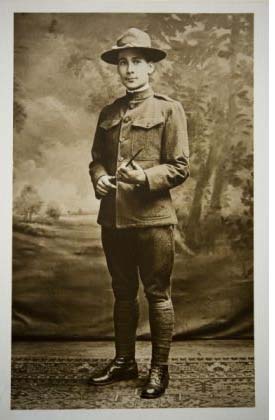 My
father, Henry Marcoux, was a salesman of fancy imported foods and
liquor on New York City's Park Avenue in 1916.
My
father, Henry Marcoux, was a salesman of fancy imported foods and
liquor on New York City's Park Avenue in 1916.
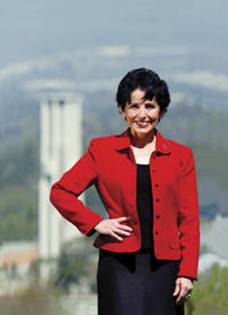
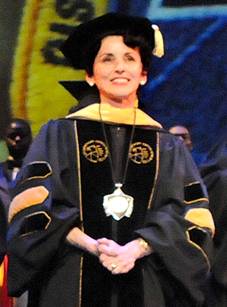
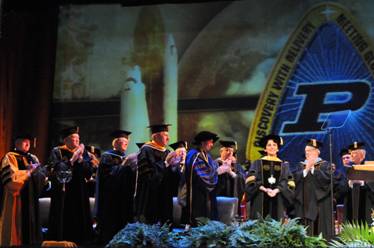
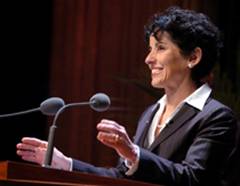 On
May 7, 2007,
On
May 7, 2007, 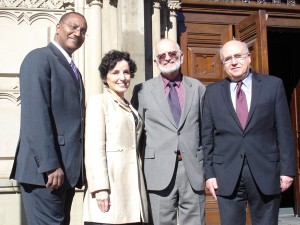
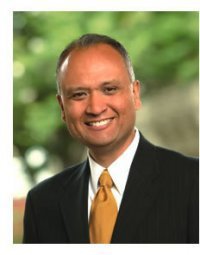
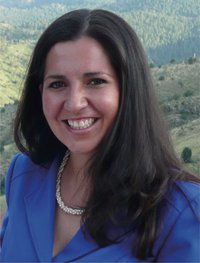 Crisanta Duran is the House District 5 Representative in the Colorado
Legislature.
Crisanta Duran is the House District 5 Representative in the Colorado
Legislature.
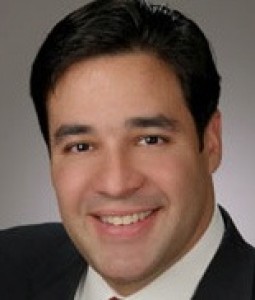 Raul Labrador is currently Western Idaho’s 1st Congressional District
Representative. He previously represented District 14B from 2006
to 2010.
Raul Labrador is currently Western Idaho’s 1st Congressional District
Representative. He previously represented District 14B from 2006
to 2010.
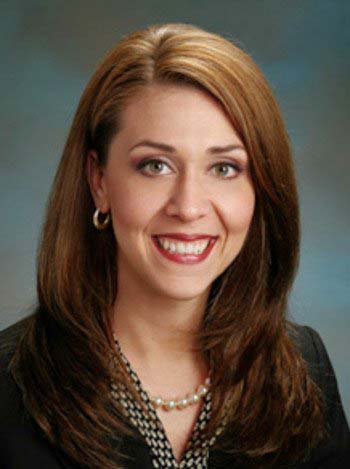 Jaime Herrera is the current U. S. Representative for Washington 3rd
Congressional District.
Jaime Herrera is the current U. S. Representative for Washington 3rd
Congressional District.
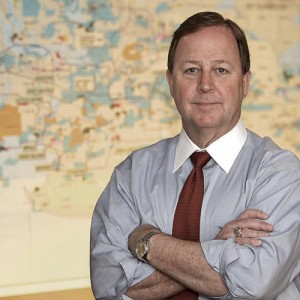 Bill Flores is the current United States Representative for Texas 17th
Congressional District.
Bill Flores is the current United States Representative for Texas 17th
Congressional District.
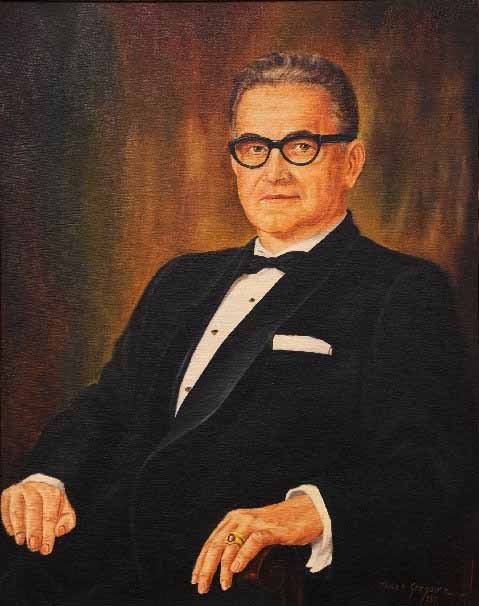
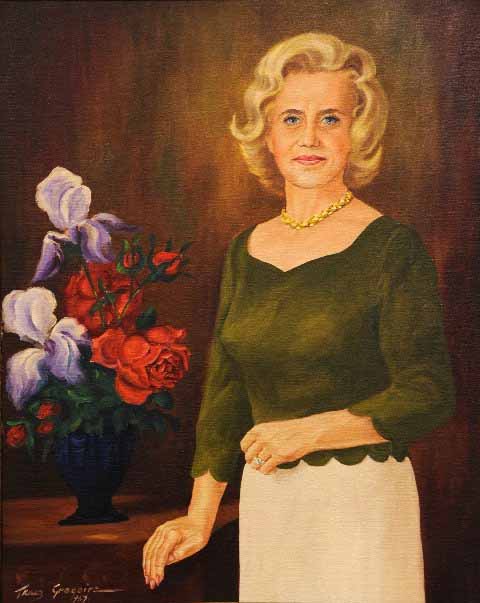
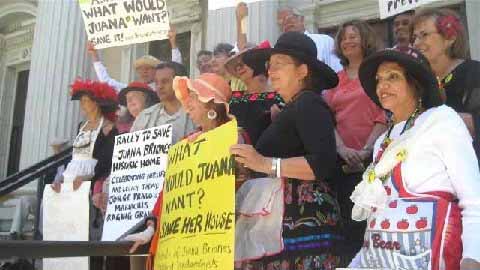
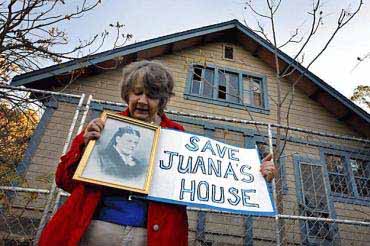
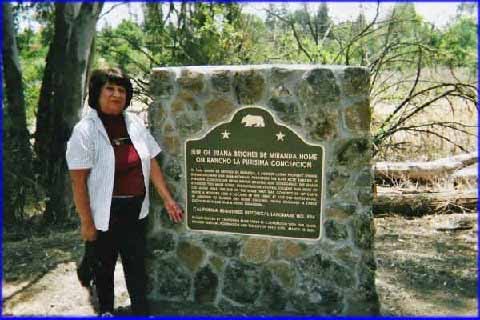
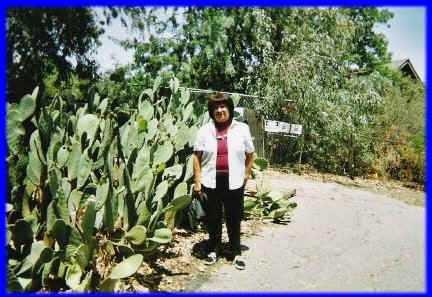
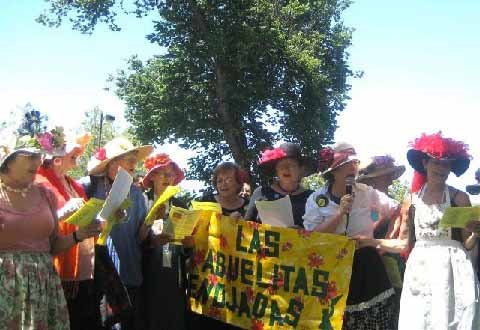
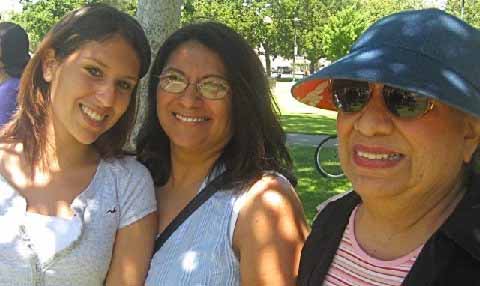
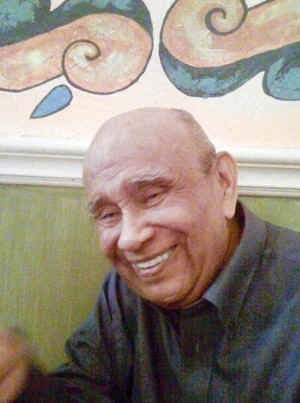
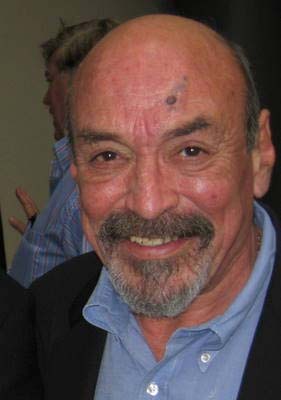 The day after Thanksgiving I went to visit him in Port Aransas, we did some NewsTaco videos and he made me Thanksgiving Dinner #2. I still have some turkey and broccoli he made in my fridge. Tonight, it dawned on me that I was probably one of the last people to hug him, peck him on the cheek and tell him that I cared for him. I wish I could say it was more than an unfortunate distinction.
The day after Thanksgiving I went to visit him in Port Aransas, we did some NewsTaco videos and he made me Thanksgiving Dinner #2. I still have some turkey and broccoli he made in my fridge. Tonight, it dawned on me that I was probably one of the last people to hug him, peck him on the cheek and tell him that I cared for him. I wish I could say it was more than an unfortunate distinction.
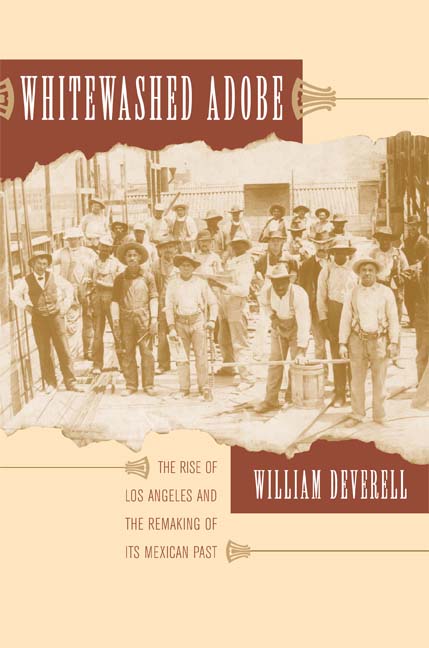

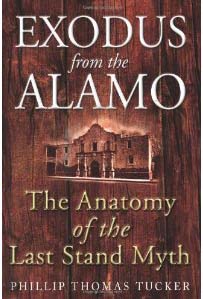

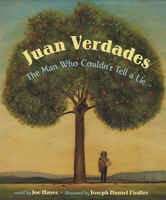
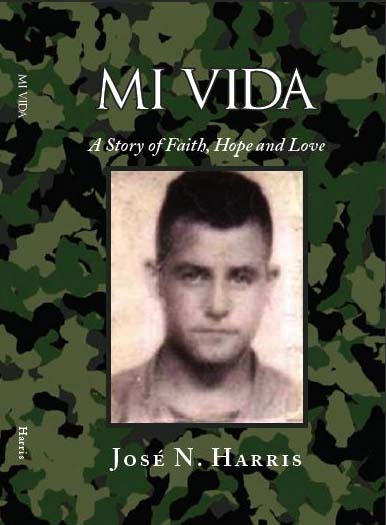











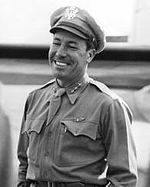
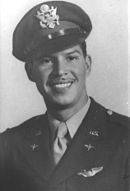
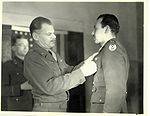


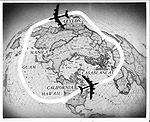

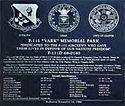
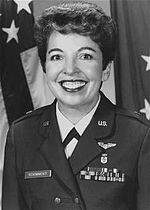
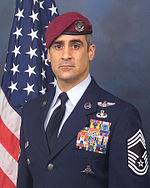
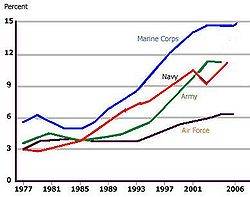
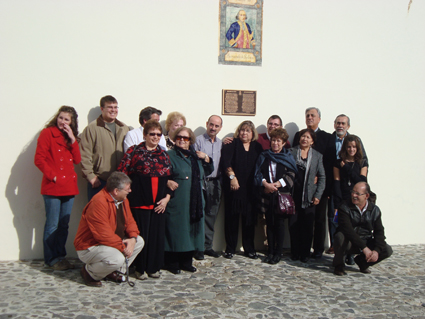
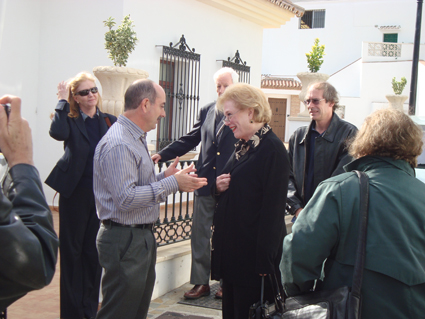
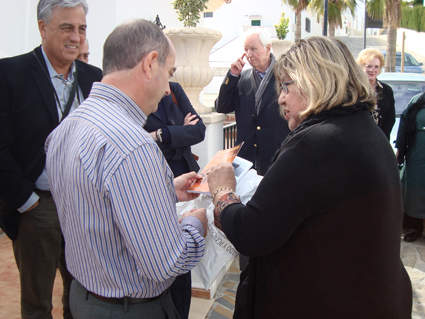
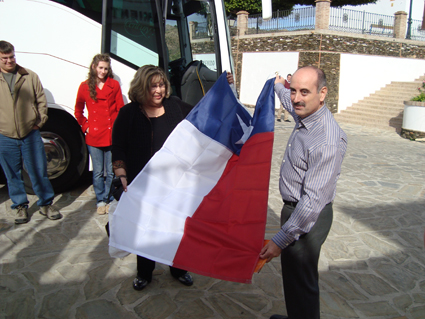
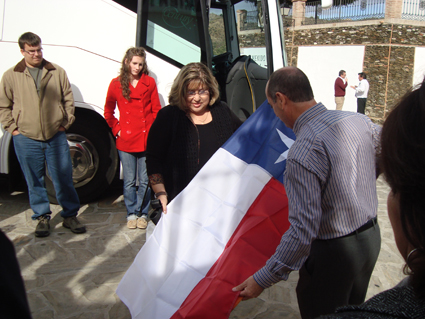
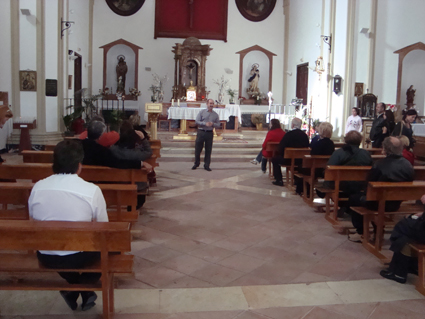
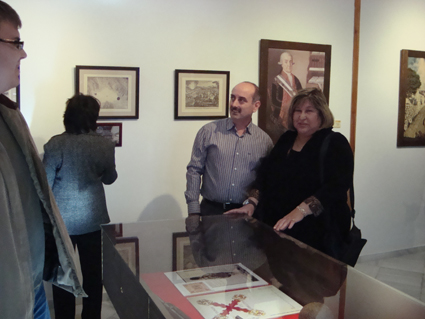
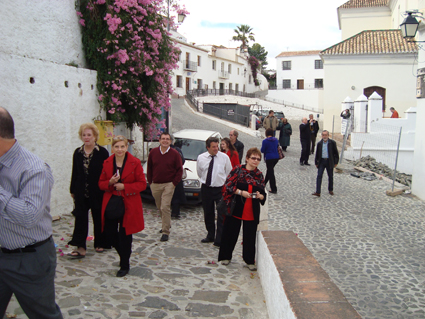


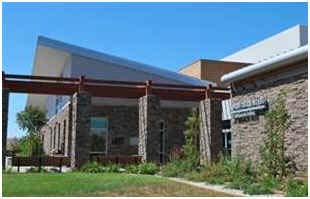 The dream is now a reality! The long awaited Sports Center at Grijalva Park is here and ready to serve its community! This state-of-the-art, energy efficient, *LEED designed 26,200-square-foot sports center is located at 368 North Prospect Avenue and features a dance room with a wood floor, ballet barres and mirrored wall, a large multipurpose room, and a spacious gymnasium with basketball and volleyball courts and plenty of fan seating.
The dream is now a reality! The long awaited Sports Center at Grijalva Park is here and ready to serve its community! This state-of-the-art, energy efficient, *LEED designed 26,200-square-foot sports center is located at 368 North Prospect Avenue and features a dance room with a wood floor, ballet barres and mirrored wall, a large multipurpose room, and a spacious gymnasium with basketball and volleyball courts and plenty of fan seating.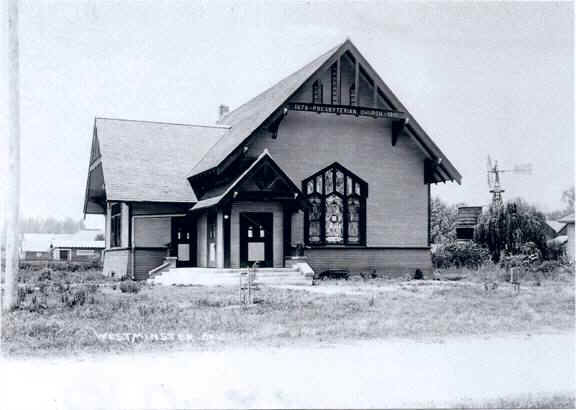
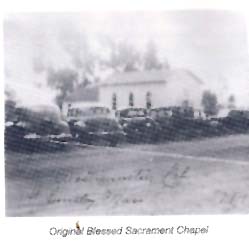
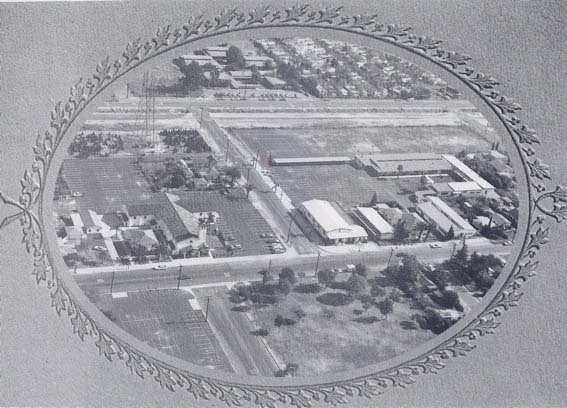
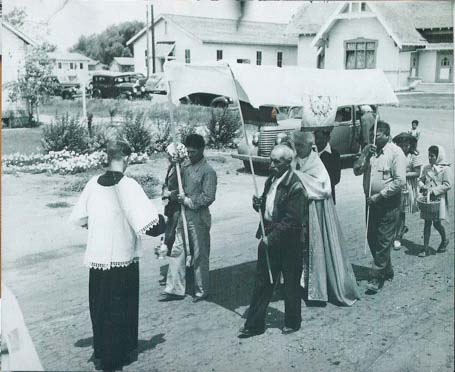
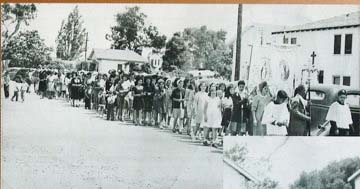
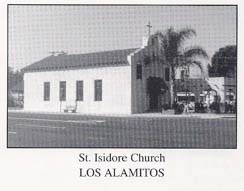 The building was for sale in 1942 when the Japanese communities in Orange County were being relocated for security reasons to remote places like Poston, Arizona and Manzanar, California. The Catholic Diocese of Los Angeles purchased the abandoned building that year.
The building was for sale in 1942 when the Japanese communities in Orange County were being relocated for security reasons to remote places like Poston, Arizona and Manzanar, California. The Catholic Diocese of Los Angeles purchased the abandoned building that year. 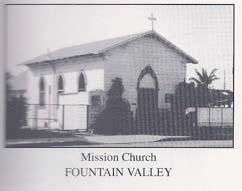 If you follow carefully the movement of the Blessed Sacrament mission church, you will notice that it’s been moved three times and not four, as Blakely observes in her article for the Westminster Herald. She no doubt meant to write that it had been at three previous different locations, that this would be its fourth move: Bolsa Avenue and Wright, the Ball Ranch, Westminster, and now Fountain Valley. May this veritable mission church building survive another 128 years!
If you follow carefully the movement of the Blessed Sacrament mission church, you will notice that it’s been moved three times and not four, as Blakely observes in her article for the Westminster Herald. She no doubt meant to write that it had been at three previous different locations, that this would be its fourth move: Bolsa Avenue and Wright, the Ball Ranch, Westminster, and now Fountain Valley. May this veritable mission church building survive another 128 years! 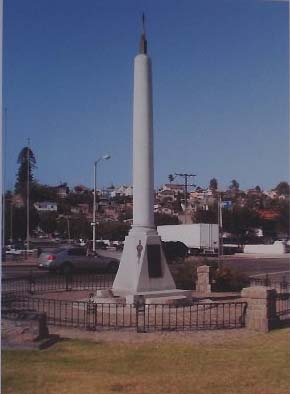 World War II was especially harsh on the Mexican-American citizens since the community experienced an inordinate amount of casualties even as they were oppressed with discrimination in housing, employment and educational opportunities. In East Los Angeles, one of the largest areas in California that houses citizens of Mexican descent, a committee was formed to draw attention to the disparities in human and civil rights despite great sacrifices for freedom’s cause
World War II was especially harsh on the Mexican-American citizens since the community experienced an inordinate amount of casualties even as they were oppressed with discrimination in housing, employment and educational opportunities. In East Los Angeles, one of the largest areas in California that houses citizens of Mexican descent, a committee was formed to draw attention to the disparities in human and civil rights despite great sacrifices for freedom’s cause